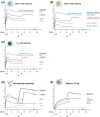Immunological memory to SARS-CoV-2 infection and COVID-19 vaccines
- PMID: 35733376
- PMCID: PMC9349657
- DOI: 10.1111/imr.13089
Immunological memory to SARS-CoV-2 infection and COVID-19 vaccines
Abstract
Immunological memory is the basis of protective immunity provided by vaccines and previous infections. Immunological memory can develop from multiple branches of the adaptive immune system, including CD4 T cells, CD8 T cells, B cells, and long-lasting antibody responses. Extraordinary progress has been made in understanding memory to SARS-CoV-2 infection and COVID-19 vaccines, addressing development; quantitative and qualitative features of different cellular and anatomical compartments; and durability of each cellular component and antibodies. Given the sophistication of the measurements; the size of the human studies; the use of longitudinal samples and cross-sectional studies; and head-to-head comparisons between infection and vaccines or between multiple vaccines, the understanding of immune memory for 1 year to SARS-CoV-2 infection and vaccines already supersedes that of any other acute infectious disease. This knowledge may help inform public policies regarding COVID-19 and COVID-19 vaccines, as well as the scientific development of future vaccines against SARS-CoV-2 and other diseases.
Keywords: adenoviral vectors; coronavirus; hybrid immunity; mRNA vaccines; memory B cells; memory T cells; natural immunity; protein vaccine.
© 2022 The Authors. Immunological Reviews published by John Wiley & Sons Ltd.
Conflict of interest statement
SC has consulted for GSK, JP Morgan, Citi, Morgan Stanley, Avalia NZ, Nutcracker Therapeutics, University of California, California State Universities, United Airlines, and Roche. A.S. is a consultant for Gritstone Bio, Flow Pharma, ImmunoScape, Moderna, AstraZeneca, Avalia, Fortress, Repertoire, Gilead, Gerson Lehrman Group, RiverVest, MedaCorp, and Guggenheim.
Figures



Similar articles
-
Durability and cross-reactive immune memory to SARS-CoV-2 in individuals 2 years after recovery from COVID-19: a longitudinal cohort study.Lancet Microbe. 2024 Jan;5(1):e24-e33. doi: 10.1016/S2666-5247(23)00255-0. Epub 2023 Dec 1. Lancet Microbe. 2024. PMID: 38048805 Free PMC article.
-
Innate and adaptive immune responses to SARS-CoV-2 in humans: relevance to acquired immunity and vaccine responses.Clin Exp Immunol. 2021 Jun;204(3):310-320. doi: 10.1111/cei.13582. Epub 2021 Mar 4. Clin Exp Immunol. 2021. PMID: 33534923 Free PMC article. Review.
-
Robust Vaccine-Induced as Well as Hybrid B- and T-Cell Immunity across SARS-CoV-2 Vaccine Platforms in People with HIV.Microbiol Spectr. 2023 Jun 15;11(3):e0115523. doi: 10.1128/spectrum.01155-23. Epub 2023 May 11. Microbiol Spectr. 2023. PMID: 37166335 Free PMC article.
-
Infection and Immune Memory: Variables in Robust Protection by Vaccines Against SARS-CoV-2.Front Immunol. 2021 May 11;12:660019. doi: 10.3389/fimmu.2021.660019. eCollection 2021. Front Immunol. 2021. PMID: 34046033 Free PMC article. Review.
-
Enhancing Immunological Memory: Unveiling Booster Doses to Bolster Vaccine Efficacy Against Evolving SARS-CoV-2 Mutant Variants.Curr Microbiol. 2024 Feb 5;81(3):91. doi: 10.1007/s00284-023-03597-2. Curr Microbiol. 2024. PMID: 38311669 Review.
Cited by
-
T-Cell Immune Responses to SARS-CoV-2 Infection and Vaccination.Vaccines (Basel). 2024 Sep 30;12(10):1126. doi: 10.3390/vaccines12101126. Vaccines (Basel). 2024. PMID: 39460293 Free PMC article. Review.
-
Humoral and cellular immune responses to CoronaVac up to one year after vaccination.Front Immunol. 2022 Oct 21;13:1032411. doi: 10.3389/fimmu.2022.1032411. eCollection 2022. Front Immunol. 2022. PMID: 36341425 Free PMC article. Clinical Trial.
-
SARS-CoV-2 Omicron boosting induces de novo B cell response in humans.bioRxiv [Preprint]. 2022 Sep 22:2022.09.22.509040. doi: 10.1101/2022.09.22.509040. bioRxiv. 2022. Update in: Nature. 2023 May;617(7961):592-598. doi: 10.1038/s41586-023-06025-4. PMID: 36172127 Free PMC article. Updated. Preprint.
-
Safety and Immunogenicity After Primary and Booster Inactivated SARS-Cov-2 Vaccination in Patients with Autoimmune Liver Diseases.J Clin Transl Hepatol. 2024 Feb 28;12(2):162-171. doi: 10.14218/JCTH.2023.00049. Epub 2023 Sep 6. J Clin Transl Hepatol. 2024. PMID: 38343613 Free PMC article.
-
Intradermal Fractional ChAdOx1 nCoV-19 Booster Vaccine Induces Memory T Cells: A Follow-Up Study.Vaccines (Basel). 2024 Jan 23;12(2):109. doi: 10.3390/vaccines12020109. Vaccines (Basel). 2024. PMID: 38400093 Free PMC article.
References
-
- Schoenberger SP, Crotty S. Immunological memory. In: Paul WE, ed. Immunological Memory. 6th ed. Lippincott Wiliams & Wilkins; 2010.
-
- Crotty S. Hybrid immunity. Science. 2021;372(6549):1392‐1393. doi:10.1126/science.abj2258 - DOI
Publication types
MeSH terms
Substances
Grants and funding
LinkOut - more resources
Full Text Sources
Other Literature Sources
Medical
Research Materials
Miscellaneous

